Spring Information Session – 2025 Redistricting Process for School Year 2026-2027
← Boundary Review Process Overview
Speaker Notes Transcript
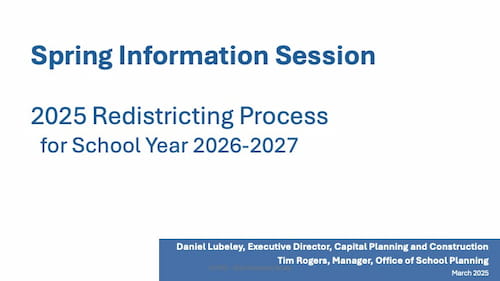
Overview
We are here today to talk about the 2025 boundary review, for implementation in school year 2026-2027. This is the first public engagement opportunity in this process our intent is to share basic information about the process and collect initial input to inform the planning that will occur. At this point, there are not any maps or plans to share and no decisions have been made.
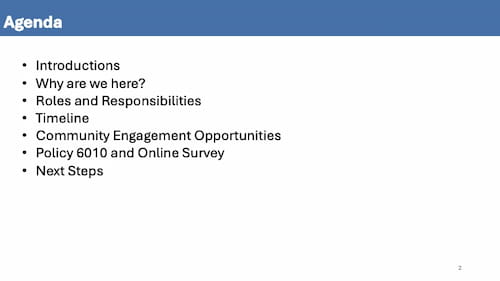
Agenda
Here is our agenda for this presentation:
We will have introductions and review the process drivers, answering the question: why are we here?
We will also review some background information, and then we will move to the most important part of this engagement which is collecting your input via online survey.
Finally, we will talk about the next steps in the process.
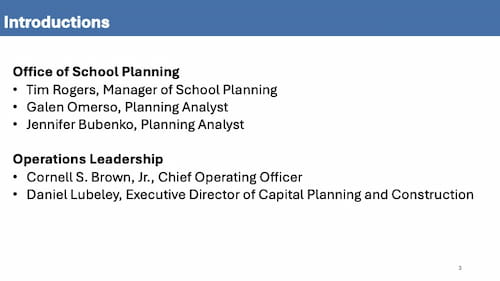
Introductions
The Office of School Planning (or OSP) staff is led by Tim Rogers with additional support from Planning Analysts Galen Omerso and Jennifer Bubenko.
We will also have involvement from Operations Leadership. This will be the Chief Operating Officer, Cornell Brown, and the Executive Director of Capital Planning and Construction, Dan Lubeley.
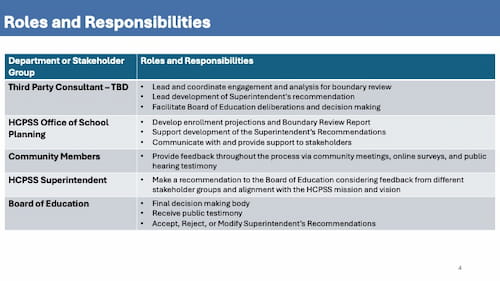
Roles and Responsibilities
In this process, it is very important to have clear delineation of roles and responsibilities for different groups and stakeholders.
A third-party consultant is anticipated to be under contract soon. They will provide objectivity and outside perspective to the process. They will also be facilitating future engagement efforts, development of the Superintendent’s proposal, and deliberations by the Board of Education this fall.
The Office of School Planning will develop enrollment projections and the Boundary Review Report. This study will include boundary adjustment scenarios based on policy considerations and initial community input.
Community members are the key stakeholders throughout the entire process. We ask that they provide feedback at community meetings, complete online surveys, and provide testimony during the Board’s Public Hearings.
Following the Boundary Review Report, the Superintendent will consider feedback from the various forms of community engagement, alignment with policy, and the mission and vision of HCPSS. He will then make a recommendation to the Board of Education.
The Board of Education is the final decision-making body in this process.
The Board will accept, reject, or modify the Superintendent’s Recommendation.
The Board will receive public testimony after the Superintendent’s recommendation and after any Board approved preliminary plan(s) before any final action is taken.
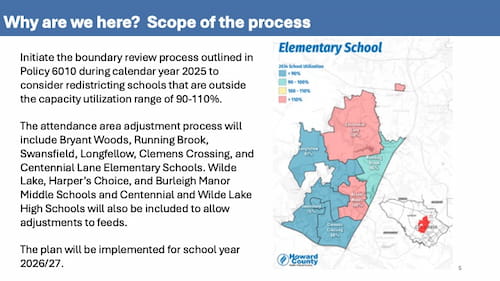
Why Are We Here?
On February 13, 2025, the Board of Education initiated the boundary review process outlined in Policy 6010 during calendar year 2025 to address certain schools that are outside the capacity utilization range of 90-110%. The attendance area adjustment review will include Bryant Woods, Running Brook, Swansfield, Clemens Crossing, and Centennial Lane Elementary Schools. These schools are either over the 110% utilization threshold or are adjacent to those schools and utilized below the target range. Wilde Lake, Harper’s Choice, and Burleigh Manor Middle Schools and Centennial and Wilde Lake High Schools will also be included to allow adjustments to feeds. The plan will be implemented for school year 2026-27.
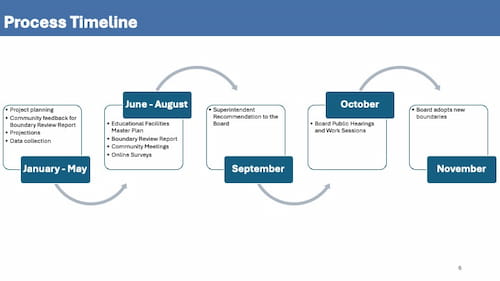
Process Timeline
The implementation procedures for Policy 6010 outline a process that runs from January through November. We are still in the beginning stages. Community input gathered in the coming weeks will inform the scenarios reported to the Board of Education by staff in June. There will be additional engagement efforts over the summer, to inform the Superintendent’s recommendation in September. The Board will consider this recommendation and any modifications or alternatives during the fall months. A final plan for attendance area adjustments for school year 2026-27 will be adopted in November of 2025.
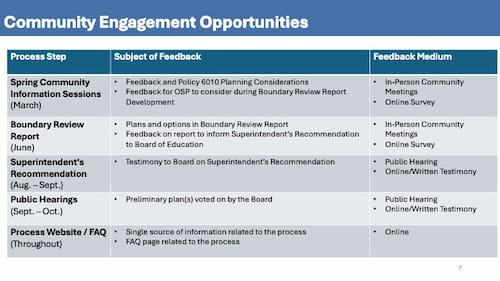
Community Engagement Opportunities
There are several engagement opportunities during the process. Again, we are in the first stage and are talking about the overall process and seeking input on the policy parameters to consider as the Boundary Review Report is developed.
This summer there will be additional engagement opportunities to receive feedback on the scenarios presented in the Boundary Review Report. The Superintendent considers all of the feedback collected to date, along with policy and the HCPSS mission and vision.
This fall the Board will conduct public hearings to receive verbal testimony. Written testimony may be submitted at that time as well.
Throughout the process, HCPSS will maintain a website with relevant data, materials, and links.
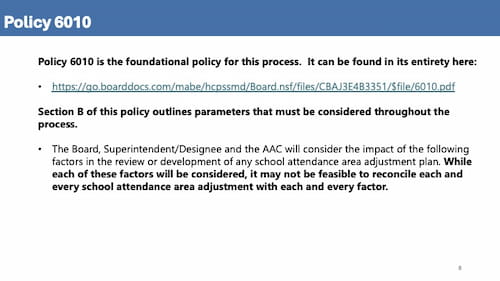
Decision Factors
Before we get into the parameters for consideration, I want to point to a section in the policy that is particularly important.
The Board, Superintendent/designee and the Attendance Area Committee (AAC), if convened, will consider the impact of the following factors during the review or development of any school attendance area adjustment plan. While each of these factors will be considered, it may not be feasible to reconcile each and every attendance area adjustment with each and every factor.
So, as you are considering your thoughts about these parameters, remember that it is very unlikely that all of them can be completely satisfied for the entire plan.
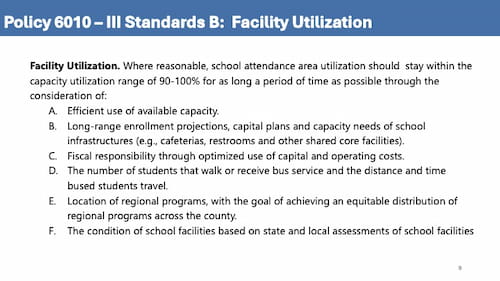
Facility Utilization
The following slides list some of the considerations in Policy 6010, starting with Facility Utilization.
Where reasonable, school attendance area utilization should stay within the capacity utilization range of 90-100% for as long a period of time as possible through the consideration of:
-
Efficient use of available capacity.
-
Long-range enrollment projections, capital plans and capacity needs of school infrastructures (e.g., cafeterias, restrooms and other shared core facilities).
-
Fiscal responsibility through optimized use of capital and operating costs.
-
The number of students that walk or receive bus service and the distance and time bused students travel.
-
Location of regional programs, with the goal of achieving an equitable distribution of regional programs across the county.
-
The condition of school facilities based on state and local assessments of school facilities.
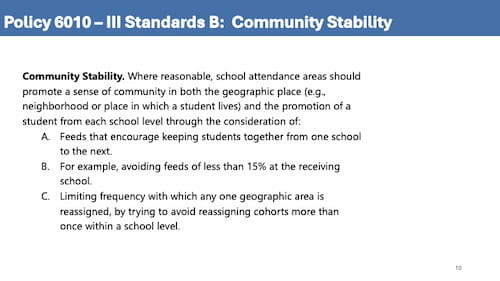
Community Stability
Moving on to Community Stability.
Where reasonable, school attendance areas should promote a sense of community in both the geographic place (e.g., neighborhood or place in which a student lives) and the promotion of a student from each school level through the consideration of:
-
Feeds that encourage keeping students together from one school to the next. For example, avoiding feeds of less than 15% at the receiving school.
-
Maintaining contiguous communities or neighborhoods.
-
Limiting frequency with which any one geographic area is reassigned, by trying to avoid reassigning cohorts more than once within a school level.
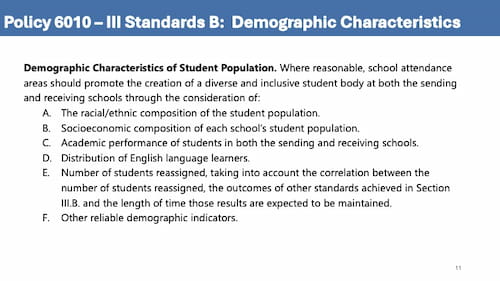
Demographic Characteristics of Student Population
And finally Demographic Characteristics of Student Population.
Where reasonable, school attendance areas should promote the creation of a diverse and inclusive student body at both the sending and receiving schools through the consideration of:
-
The racial/ethnic composition of the student population.
-
Socioeconomic composition of each school’s student population.
-
Academic performance of students in both the sending and receiving schools.
-
Distribution of English language learners.
-
Number of students reassigned, taking into account the correlation between the number of students reassigned, the outcomes of other standards achieved in Section III.B. and the length of time those results are expected to be maintained.
-
Other reliable demographic indicators.
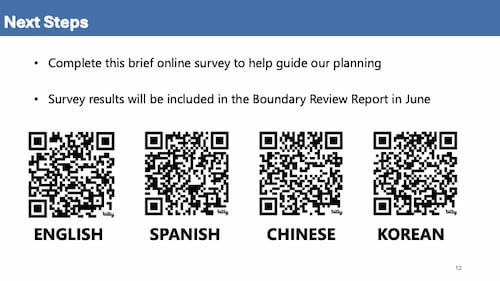
Provide Input
As a reminder, if you have not done so already, please provide your input through the online survey. The questions are intended to collect your overall preferences on the policy parameters as they apply to the current redistricting process.
The link to the survey can be found online, but the direct link is:
https://forms.office.com/r/pXnBP95A88
The survey will be open through April 30.
As far as next steps go, the Boundary Review Report will be published in June. At that time, there will be opportunities for your feedback in the form of community meetings and online surveys. We look forward to this being informative and transparent process.